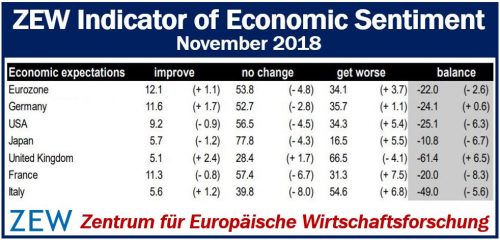The ZEW Indicator of Economic Sentiment is a monthly survey of economists and analysts. They assess the economic conditions of Germany as well as several regions and nations.
If the resulting index is greater than zero, sentiment is positive. If it is less than zero, on the other hand, there is a negative outlook.
ZEW stands for Zentrum für Europäische Wirtschaftsforschung, which is German for the Centre for European Economic Research. It is an economic research institute and a member of the Leibniz Association. It is one of Europe’s leading economic research institutes.
ZEW Indicator of Economic Sentiment – the German economy
The survey is a leading indicator for the German economy. However, it also asks experts what their expectations are for other parts of the world. Specifically, they ask them about the United States, Eurozone, Japan, United Kingdom, France, and Italy.
According to Centre for European Economic Research:
“The ZEW Indicator of Economic Sentiment is calculated from the results of the ZEW Financial Market Survey. It is constructed as the difference between the percentage share of analysts that are optimistic and the share of analysts that are pessimistic for the German economy in six months.”

An example
Let’s suppose that 40% of participants expect, for example, the US’ economic situation to improve within the next six months. Thirty percent expect the economic situation to deteriorate and thirty percent expect no change.
The ZEW Indicator of Economic Sentiment for the US would take a value of +10. Therefore, the outlook would be positive.
If the value had been, for example, minus ten, the outlook would have been negative.
In November 2018, the ZEW Indicator of Economic Sentiment regarding economic expectations was negative for every region. The United States stood at -25.1, the Eurozone at -22, Japan at -10.8, Italy at -49, and France at -20. The UK’s outlook at -61.4, looked particularly negative.
ZEW also publishes data on each country’s or region’s short- and long-term interest rates, inflation rates, commodities, exchange rates, and stock market indices.
Commodities are raw materials and primary agricultural products rather than manufactured goods. Gold, silver, coffee, and wheat, for example, are commodities.
